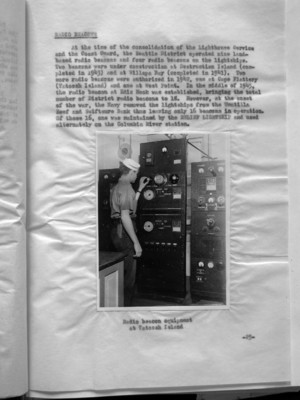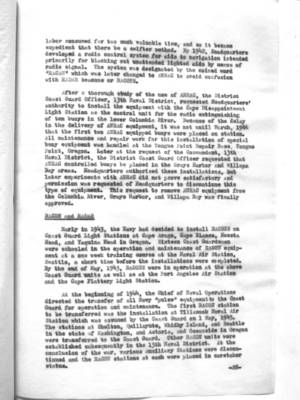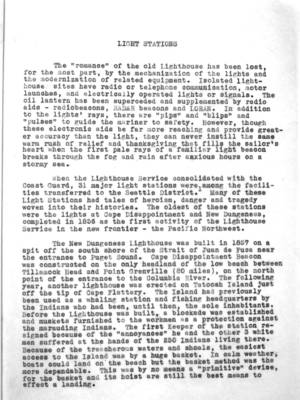Pages That Mention Cape Flattery
Coast Guard District narrative histories 1945
8
At the time of the consolidation of the Lighthouse Service and the Coast Guard, the Seattle District operated nine land-based radio beacons and four radio beacons on the lightships. Two beacons were under construction at Destruction Island (completed in 1943) and at Willapa Bay (completed in 1941). Two more radio beacons were authorized in 1942, one at Cape Flattery (Tatoosh Island) and one at West Point. In the middle of 1945, the radio beacon at Ediz Hook was established, bringing the total number of District radio beacons to 18. However, at the onset of the war, the Navy removed the lightships from the Umatilla Reef and Swiftsure Bank thus leaving only 16 beacons in operation. Of these 16, one was maintained by the RELIEF LIGHTSHIP and used alternatively on the Columbia River station.
(Photo inserted here)
Radio beacon equipment at Tatoosh Island
-25-
11
labor consumed far too much valuable time, and so it became expedient that there be a swifter method. By 1942, Headquarters developed a radio control system for aids to navigation intended primarily for blacking out unattended lighted aids by means of radio signal. The system was designated by the coined word "RACAN" which was later changed to ANRAC to avoid confusion with RADAR beacons or RACONS.
After a thorough study of the use of ANRAC, the District Coast Guard Officer, 13th Naval District, requested Headquarters' authority to install the equipment with the Cape Disappointment Light Station as the control unit for the radio extinguishing of ten buoys in the lower Columbia River. Because of the delay in the delivery of ANRAC equipment, it was not until March, 1944 that the first two ANRAC equipped buoys were placed on station. All maintenance and repair work for this installation of special buoy equipment was handled at the Tongue Point Repair Base, Tongue Point, Oregon. Later at the request of the Commandant, 13th Naval District, the District Coast Guard Officer requested that ANRAC controlled buoys be placed in the Grays Harbor and Willapa Bay areas. Headquarters authorized these installations, but later experiments with ANRAC did not prove satisfactory and permission was requested of Headquarters to discontinue this type of equipment. This request to remove ANRAC equipment from the Columbia River, Grays Harbor, and Willapa Bay was finally approved.
Early in 1943, the Navy had decided to install RACONS on Coast Guard Light Stations at Cape Arago, Cape Blanco, Heceta Head, and Yaquina Head in Oregon. Sixteen Coast Guardsmen were schooled in the operation and maintenance of RACON equipment at a one week training course at the Naval Air Station, Seattle, a short time before the installations were completed. By the end of May, 1943, RACONS were in operation at the above Coast Guard units as well as at the Port Angeles Air Station and the Cape Flattery Light Station.
At the beginning of 1944, the Chief of Naval Operations directed the transfer of all Navy "pulse" equipment to the Coast Guard for operation and maintenance. The first RACON station to be transferred was the installation at Tillamook Naval Air Station which was assumed by the Coast Guard on 1 May, 1945. The stations at Shelton, Quillayute, Whidby Island, and Seattle in the state of Washington, and Astoria, and Oceanside in Oregon were transferred to the Coast Guard. Other RACON units were established subsequently in the 13th Naval District. At the conclusion of the war, various Auxiliary Stations were discontinued and the RACON stations at each were placed in caretaker status.
-28-
20
LIGHT STATIONS
The "romance" of the old Lighthouse has been lost, for the most part, by the mechanization of the lights and the modernization of related equipment. Isolated lighthouse sites have radio or telephone communication, motor launches, and electrically operated lights or signals. The oil lantern has been superceded and supplemented by radio aids - raidobeacons, RADAR beacons and LORAN. In addition to the lights' rays, there are "pips" and "blips" and "pulses" to guide the mariner to safety. However, though these electronic aids be far more reaching and provide greater accuracy than the light, they can never instill the same warm rush of relief and thanksgiving that fills the sailor's heart when the first pale rays of a familiar light beacon breaks through the fog and rain after anxious hours on a stormy sea.
When the Lighthouse Service consolidated with the Coast Guard, 31 major light stations were among the facilities transferred to the Seattle District.¹ Many of these Light Stations had tales of heroism, danger and tragedy woven into their histories. The oldest of these stations were the lights at Cape Disappointment and New Dungeness, completed in 1856 as the first activity of the Lighthouse Service in the new frontier - the Pacific Northwest.
The New Dungeness Lighthouse was built in 1857 on a spit off the south shore of the Strait of Juan de Fuca near the entrance to Puget Sound. Cape Disappointment Beacon was constructed on the only headland of the low beach between Tillamook Head and Point Grenville (80 miles), on the north point of the entrance to the Columbia River. The following year, another lighthouse was erected on Tatoosh Island just off the tip of Cape Flattery. The Island had previously been used as a whaling station and fishing headquarters by the Indians who had been, until then, the sole inhabitants. Before the Lighthouse was built, a blockade was established and muskets furnished to the workmen as protection against marauding Indians. The first Keeper of the station resigned because of the "annoyances" he and the other 3 white men suffered at the hands of the 250 Indians living there. Because of the treacherous waters and shoals, the easiest access to the Island was by a huge basket. In calm weather, boats could land on the beach but the basket method was the more dependable. This was by no means a "primitive" devise, for the basket and its hoist are still the best means to effect a landing.
22
to the 350 watt and 750 watt electric lamps of today; this limitation permitted slight variation in the range of the lighted beacons. The lenses increased and magnified the light as they revolved to produce a flashing effect.
Reminicenses of the Lighthouse men who tended these lights during the years when the Northwest was, for the most part, a mountainous wilderness, make interesting listening. Even after the invention of railroads, telephones and the automobile, trips to coastal Light Stations involved travel by boat, stage and horseback. Stage drivers informed passengers before the journey began, that there was no guarantee that the stage could complete the trip, in which event, the traveller made the remainder of his journey on foot. Seasonal rains, washouts, and the miserable conditions of the "roads" (deer trails, or Indian paths) made such stipulations a necessity. Today's brief trip from Bandon to Cape Blanco, Oregon, can be made either way in a fraction of an hour; earlier travellers spent three days; The uncertainty of transportation was illustrated in the following anecdote: An engineer of the Lighthouse Service was called to Destruction Island to repair the boilers. A buoy tender took the engineer to the Island and he requested that the tender return on Friday to pick him up. Friday came - and went; another Friday - no tender; a third Friday - and in the distance the curl of a tender's smoke was seen on the horizon (in those days the smoke trails of the various type ships identified them to the men whose idle hours were spent watching the horizon for the vessels that occasionally appeared there.) When the Master of the tender was admonished for his tardiness, he replied, "You said to come on Friday; isn't this Friday?". Time was of little import.
Life on the Light Stations until the middle thirties was a world of its own. Because of their locations there were no telephone facilities, and commercial electric power did not reach to the outposts. There were generally two keepers and their families assigned to each station and the competition for the most tidy and efficient station among the keepers was keen. A few of the isolated stations at Tillamook Rock, Destruction Island, Cape Flattery, etc. had four or five keepers, one on continuous liberty rotation. With the installation of radiobeacons at many of the stations, it became necessary to bring in commercial electric power or generate power at the station. With electricity available, the i.c.v. light was superceded, the fog signals mechanized, and the comforts of the keeper's dwellings increased. Telephone service or radio-telephone service soon followed as
23
the construction of roads by the State Highway Departments made the outlying stations more readily accessible.
Seventy keepers were in residence on the Stations when the Lighthouse Service was consolidated with the Coast Guard in 1939. During the war, this number had increased to 176 on these stations. The increase was due, primarily, to the fact that unskilled men inducted into the Service had not the training, background, nor interest in the Station which was common to the men earlier assigned there. Furthermore, the work at the station increased during the war years; Coastal Lookout units with their dogs and horses were generally located on Station grounds. this necessitated turning the dwellings of the Keepers into barracks to quarter the increased personnel and building kennels, stables and shelters for equipment. The end of the war began the gradual reduction of the Stations to their normal peacetime complements.
Early in the war, the Commandant, 13th Naval District, ordered the concealment of ten of the Light Stations that were near military areas or war industries. The walls were "toned down" with gray and the space under the eaves painted black to accentuate the silouette of the Station as it appeared from the water. (Tongue Point Repair Base was provided with a camouflage net to cover the wharves where vari-colored buoys and markers were stored. This Base was in the vicinity of the Naval Air Station, Astoria, and the work was done in conjunction with assistance from that activity.) Army activities near Coast Guard units furnished the paint for camouflaging the structures. The last of the stations was returned to its normal peace time color by the end of the summer, 1945. (See sixth page for camouflage technique)
A continuous lookout adwatch was maintained by the Keepers of New Dungeness, Ediz Hook, Slip Point and Cape Flattery Lighthouses beginning, strangely enough, 6 December, 1941. All vessels, aircraft, or any suspicious activity (such as attempts at communications between persons on shore (such as attempts at communications between persons on shore and unidentified vessels) were reported to Naval Section Base at Port Angeles and the Harbor Defense, Fort Worden. This order directed that persons engaged in suspicious activity should be apprehended and taken into custody. However, this directive was rescinded and, rather than take such individuals into custody, observers notified the nearest Army or Navy intelligence who took the necessary action.
Drills in the use of the gas mask were held at all Light Stations and a course in Chemical Warfare was complusory




